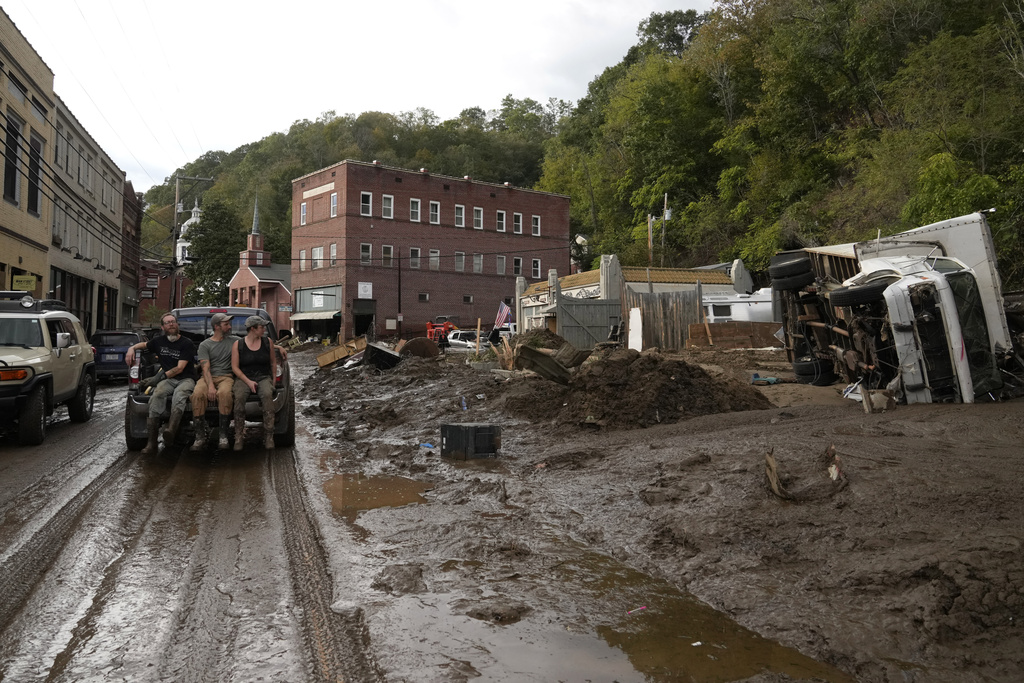North Carolina Struggles After Hurricane Helene, Residents Adapt \ Newslooks \ Washington DC \ Mary Sidiqi \ Evening Edition \ After Hurricane Helene devastated the Southeast, western North Carolina residents are relying on traditional means of communication in isolated areas without power or phone service. Community leaders are shouting updates, while residents adapt by carrying water and cooking with propane. President Joe Biden will visit the Carolinas as recovery efforts continue.

North Carolina Adapts Post-Hurricane Helene: Quick Looks
- No Power or Communication: Western North Carolina remains isolated without electricity or phone service.
- Community Adaptation: Residents rely on traditional communication; local leaders shout updates, mules deliver supplies.
- Biden’s Visit: President Biden and Vice President Harris are visiting affected areas for firsthand assessments.
- Severe Damage: Over 1.1 million remain without power in the Carolinas and Georgia.
- Old-School Communication: In Black Mountain, officials use picnic tables to deliver updates, while missing persons are listed on makeshift boards.
- Water Scarcity: Many communities rely on creeks for water and propane grills for cooking.
- Support from Neighbors: Locals share food and resources, watching out for one another as help trickles in.
- Economic Impact: Biden estimates recovery costs will reach billions as power restoration and rebuilding efforts unfold.
Deep Look
Nearly a week after Hurricane Helene wreaked havoc across the Southeastern United States, residents of western North Carolina are relying on old-fashioned methods of communication and community support to cope. Isolated and without power or phone service, the mountain communities have adapted to their challenging circumstances, leaning on each other and traditional survival techniques.
In Black Mountain, North Carolina, residents are gathering at the town square to get news in person. Local leaders stand atop picnic tables, shouting updates on when power might be restored and where supplies can be accessed. Along fencerows, handwritten messages list the names of those still missing, while mules deliver crucial medical supplies to families cut off in mountaintop homes.
While government cargo planes are air-dropping food and water to the hardest-hit areas, rescue crews wade through floodwaters to search for survivors. The hurricane has left at least 179 people dead, and those who survived are coming together, relying on each other instead of modern technology to get by.
“We have no water; we have no power; but I think it’s also been humbling,” said Anna Ramsey, who carried water in plastic bags with her two children from a distribution point in Asheville. “It’s been humbling… what we need to do for ourselves.”
Without power and with fallen trees blocking access to her home, Ramsey and her family had to bail water from a creek in their backyard to flush toilets and cook meals on a propane grill. The storm’s devastation has forced residents to revert to simpler ways of life while they wait for aid and assistance.
President Joe Biden surveyed the extent of the hurricane’s devastation on Wednesday, flying over both North and South Carolina. Biden also announced that 1,000 active-duty soldiers from the Defense Department would be deployed to help distribute food, water, and supplies. His trip to the region came as part of a broader effort to assess the impact of the storm, which has hit several states hard and left millions without basic utilities.
In the more remote mountain regions of western North Carolina, rescue teams have been using helicopters to hoist stranded residents to safety. On the ground, search crews continue to wade through creeks and cut through fallen trees, moving door to door to locate any survivors. In some areas, homes teeter precariously on hillsides and riverbanks that have been washed away by floodwaters.
More than 1.1 million customers were still without power as of Wednesday in the Carolinas and Georgia, as Helene, which made landfall in Florida as a Category 4 hurricane, left a trail of devastation across multiple states. Deaths have been reported in six states: Florida, Georgia, Tennessee, Virginia, and the Carolinas.
In Asheville, people are coming together to support each other, ensuring that those in need are cared for despite the dire circumstances. Robin Wynn, an Asheville resident, described how she waded through knee-deep water to get to safety with a bag of canned goods and water. “I didn’t know where I was going, didn’t know what was going to happen next. But I got out and I’m alive,” Wynn said. Now back home, she noted that neighbors are helping one another, providing hot meals and ensuring that everyone has access to water.
The widespread damage to power and communications infrastructure has left many people without stable access to the internet or cell service, which has complicated rescue and relief efforts. Zeb Smathers, the mayor of Canton, North Carolina, described seeing residents holding their phones in the air, desperately trying to catch a signal “like it’s a butterfly.”
Volunteers in Asheville have been gathering to assist in search efforts, carrying boxes of drinking water and checking in on residents who have been unreachable because of the lack of phone or internet access. Their instructions were simple: deliver water and return in person with any information on the residents’ wellbeing. Even notifying the relatives of people who died in the storm has been challenging due to the lack of communication. “That has been our challenge, quite honestly — no cell service, no way to reach out to next of kin,” said Avril Pinder, an official in Buncombe County, where at least 57 people have died. “We have a confirmed body count, but we don’t have identifications on everyone or next-of-kin notifications.”
President Biden visited the Carolinas on Wednesday to view the extensive damage and pledged further federal assistance. He stated on Tuesday that the cost of recovery would likely run into billions, emphasizing the urgency of the situation: “People are scared to death. This is urgent,” Biden said. Vice President Kamala Harris was also in the region, visiting Georgia to assess the damage. Biden plans to return to the disaster zones in Florida and Georgia on Thursday.
The devastation caused by Hurricane Helene was not limited to North Carolina. In Tennessee, a tragic incident at a plastics factory left 11 workers stranded as floodwaters inundated their workplace. Despite the impending danger, workers were kept on the job until the parking lot flooded and the power went out. Of the 11, only five were rescued, while two have been confirmed dead. State authorities are investigating the company, following claims from employees that they were not allowed to leave in time to escape the storm’s impact.
Hospitals and healthcare facilities across the Southeast have remained operational for the most part, despite blackouts, wind damage, and flooding. Many hospitals suspended elective procedures, and only a few were forced to shut down entirely. In Asheville, water scarcity remains a significant issue, with officials stating that it could take weeks before full water service is restored to Buncombe County’s 275,000 residents. Thousands of feet of piping from one of Asheville’s reservoirs were washed out and will need to be rebuilt, while a second water intake system remains non-functional. “There are portions of our distribution system that are going to have to be completely rebuilt,” said Clay Chandler, a spokesperson for Asheville’s water system.
Farther south, in Florida, coastal communities continue to grapple with the damage left by Hurricane Helene. Roads are lined with enormous piles of debris, and tons of sand carried inland by the massive storm surge are still being cleared. The long path to recovery for many of these communities underscores the vast scale of the devastation brought by the hurricane.
In the absence of modern communication systems, communities in western North Carolina have shown resilience, finding ways to adapt and survive despite the lack of power and cell service. The storm has brought people together, with neighbors helping neighbors and volunteers venturing out to check on those in need. For many, the hurricane has been a humbling experience, reminding them of the importance of self-reliance and community in the face of disaster.
North Carolina Struggles North Carolina Struggles North Carolina Struggles North Carolina Struggles







